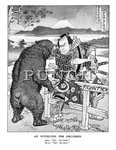Navigation
Install the app
How to install the app on iOS
Follow along with the video below to see how to install our site as a web app on your home screen.
Note: This feature may not be available in some browsers.
More options
You are using an out of date browser. It may not display this or other websites correctly.
You should upgrade or use an alternative browser.
You should upgrade or use an alternative browser.
Picture of the day. (9 Viewers)
- Thread starter syscom3
- Start date
Ad: This forum contains affiliate links to products on Amazon and eBay. More information in Terms and rules
More options
Who Replied?michaelmaltby
Colonel
Old Wizard
2nd Lieutenant
michaelmaltby
Colonel
Just started reading "Nomonhan, 1939", Stuart Goldman, which examines the conflict in the context of Stalin's Soviet geopolitical strategy. This is a topic of great interest to me .... the issue as portrayed in Punch, and battlefield artifacts.
Attachments
Last edited:
michaelmaltby
Colonel
michaelmaltby
Colonel
michaelmaltby
Colonel
Old Wizard
2nd Lieutenant
That color picture above, are you telling that there is still tanks and shells just laying about there unmolested?
Snautzer01
Marshal
- 46,292
- Mar 26, 2007
Japanese Type 91 Machine Gun

michaelmaltby
Colonel
Capt Vick .... yes and no .... you judge.
Goldman, whose book I'm reading has this to say:
Travel: Khalkhin Gol, Mongolia | HistoryNet

Goldman, whose book I'm reading has this to say:
Travel: Khalkhin Gol, Mongolia | HistoryNet
michaelmaltby
Colonel
Japanese medic works on wounded Soviet

michaelmaltby
Colonel
BT tank crew surrender

michaelmaltby
Colonel
Confident Japanese troops ... elite ... beside Soviet armored car
Last edited:
michaelmaltby
Colonel
"...I stand with awe on Fui Heights, the northern anchor of the Japanese line in the late-August climax of the battle, where a mixed battalion of 800 Japanese infantry held off a Soviet force of over 10,000 mechanized infantry and armor for three days before being driven from the heights, enabling Zhukov to encircle and annihilate the Japanese Sixth Army...." [Goldman]
****
On June 1, the burly 42-year-old Zhukov, then deputy commander of the Belorussian military district, received an urgent phone call to hurry to Moscow. With Stalin's bloody purge of the Soviet officer corps a very fresh memory, such a summons was most unwelcome. But the rising cavalry and tank commander was not destined for a bullet in a secret police execution cellar. Instead, he was briefed on the recent fighting at Nomonhan. He was instructed to fly there immediately, assess the situation, and if he deemed it necessary, take command. "Please," the deputy chief of the general staff urged him. "The moment you arrive, see what's going on out there and report to us, without pulling any punches."
On June 5, Zhukov arrived in Tamsag Bulak, the Soviet 57th Corps' headquarters in Mongolia, about 100 miles west of Nomonhan. He quickly concluded that corps commander N. V. Feklenko and most of his staff were out of touch with the situation. Only one senior staff officer had visited the combat zone; Zhukov took that officer with him on a tour of the front. Zhukov reported to Moscow that the battle at Nomonhan did not appear to be a mere border clash, that the Japanese were likely to escalate their aggression soon, and that 57th Corps and its leadership would not be adequate to stop the aggression. Zhukov recommended a temporary holding action to safeguard the bridgehead east of the Khalkha River until major reinforcements could be brought up for a counteroffensive.
Feklenko was promptly relieved of his command and Zhukov named to replace him. Zhukov's force was strengthened with powerful reinforcements—the 36th Mechanized Infantry Division; the 7th, 8th, and 9th Mechanized Infantry Brigades; the 11th Tank Brigade; a heavy artillery unit equipped with 150mm guns; the 8th Mongolian People's Republic Cavalry Division; and a tactical air wing with more than 100 aircraft—and designated 1st Army Group. [Goldman]
****
On June 1, the burly 42-year-old Zhukov, then deputy commander of the Belorussian military district, received an urgent phone call to hurry to Moscow. With Stalin's bloody purge of the Soviet officer corps a very fresh memory, such a summons was most unwelcome. But the rising cavalry and tank commander was not destined for a bullet in a secret police execution cellar. Instead, he was briefed on the recent fighting at Nomonhan. He was instructed to fly there immediately, assess the situation, and if he deemed it necessary, take command. "Please," the deputy chief of the general staff urged him. "The moment you arrive, see what's going on out there and report to us, without pulling any punches."
On June 5, Zhukov arrived in Tamsag Bulak, the Soviet 57th Corps' headquarters in Mongolia, about 100 miles west of Nomonhan. He quickly concluded that corps commander N. V. Feklenko and most of his staff were out of touch with the situation. Only one senior staff officer had visited the combat zone; Zhukov took that officer with him on a tour of the front. Zhukov reported to Moscow that the battle at Nomonhan did not appear to be a mere border clash, that the Japanese were likely to escalate their aggression soon, and that 57th Corps and its leadership would not be adequate to stop the aggression. Zhukov recommended a temporary holding action to safeguard the bridgehead east of the Khalkha River until major reinforcements could be brought up for a counteroffensive.
Feklenko was promptly relieved of his command and Zhukov named to replace him. Zhukov's force was strengthened with powerful reinforcements—the 36th Mechanized Infantry Division; the 7th, 8th, and 9th Mechanized Infantry Brigades; the 11th Tank Brigade; a heavy artillery unit equipped with 150mm guns; the 8th Mongolian People's Republic Cavalry Division; and a tactical air wing with more than 100 aircraft—and designated 1st Army Group. [Goldman]
Last edited:
Users who are viewing this thread
Total: 10 (members: 0, guests: 10)
Similar threads
- Replies
- 9
- Views
- 2K

